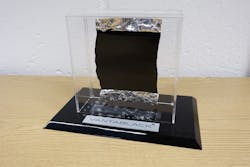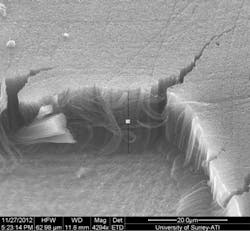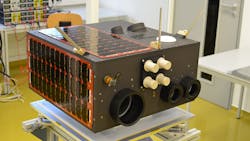Download this article as a .PDF
The material has been termed “blacker than black” and for a good reason. UK-based Surrey NanoSystems’ VantaBlack can absorb 99.96% of the radiation in the visible spectrum and even those beyond human sight, including UV and IR. While that is an astounding feat in its own right, Vantablack’s properties also give it excellent front-to-back thermal conduction and high thermal shock resistance. Throw in the fact that it’s also super-hydrophobic, and you have a trifecta in material design that can be applied to everything from space exploration to thermal camouflage.
The secret to Vantablack’s amazing properties lies within its name—in this case, Vertically Aligned Carbon NanoTube Arrays (hence Vanta), which are grown by the billions on a substrate using a modified chemical vapor deposition process. Each tube is about 20 nm in diameter and anywhere from 14 to 5 µm long so you can fit around a billion of them onto a centimeter-square substrate.
It’s this tightly packed forest of carbon nanotubes that traps incoming light, bouncing the photons between the microscopic spaces that separate each tube, where they eventually dissipate as heat. Thanks to the high thermal conduction of the material, there is very little outgassing or particle fallout, allowing them to be deposited on substrates with low thermal tolerances.
There are three versions of Vantablack that have been developed by Surrey NanoSystems, all of which have variations on their light absorption capabilities, heat temperance, and application processes—with the first being the original mentioned earlier, and the second known as S-VIS. The later version is unique in that it’s sprayed on (no, not using a spray can) to a material rather than vapor deposited, which means it can be directly applied to any number of surface materials.
Being in an aerosol format, the nanotubes are no longer aligned but scattered, which means that Vantablack’s light-absorbing properties are diminished and reflect around 0.23% of the visible spectrum. Another drawback is that you still need to bake the material after it’s been applied, limiting what substrates you can use. On the other hand, it’s perfect for a 3D object or complex-shape applications that have no flat surfaces.
The third version of Vantablack is known as 2.0 and is rumored to be darker than the original. So much so in fact, that according to Surrey, “We have never before made a material so ‘black’ that we can’t measure it on our UV-VIS or MID-IR spectrometers.” The company has released little in regard to information on 2.0 other than a demonstration video showing its prowess in absorbing laser light.
The applications for Vantablack are as numerous as you might imagine. However, optical uses are most certainly on top and benefit the most from the material’s light-absorbing and low outgassing features. Pair it with precision IR imaging platforms such as FLIR, and you now have a high-resolution system that can differentiate between heat sources. Use it in Earth-based telescopes for reduced atmospheric distortion and virtually no stray light refraction from polished lenses.
The pinnacle of optical application has already been field-tested with the National University of Singapore’s Kent Ridge 1 star tracking microsatellite, which launched in 2015. Its mission is to monitor Earth’s climate and ecosystems, as well as any environmental disasters that may occur during the satellite’s operational lifetime. One of the ways it maintains an equatorial orbit is through the use of star trackers mounted to the side of the satellite, which was coated internally with Vantablack. This allows them to absorb all “incident light,” or stray light, entering the imaging sensors. This provides increased accuracy in positioning based on star maps, which can be difficult with the amount of reflected and stray light coming from the sun and other stars.
To put that into perspective, Apollo 15 Command Module Pilot Al Warden had to use a sextant to navigate on the dark side of the moon because the space behind it was washed in starlight from the Milky Way galaxy, and the flight computers couldn’t pick out the patterns needed for navigation. Perhaps if the optical cavities had been coated with the Vantablack material it wouldn’t have been an issue.
Does that mean there’s a possibility NASA and civilian agency’s such as SpaceX will use the material for the next generation of space exploration? I’d bet money on it, as Surrey NanoSystems will only license the material to academic, research, and government institutions—us civilians can’t even get a sample. Still, it will be interesting to see where the continued development of Vantablack will lead, and what applications it can be used for in the next few years.




